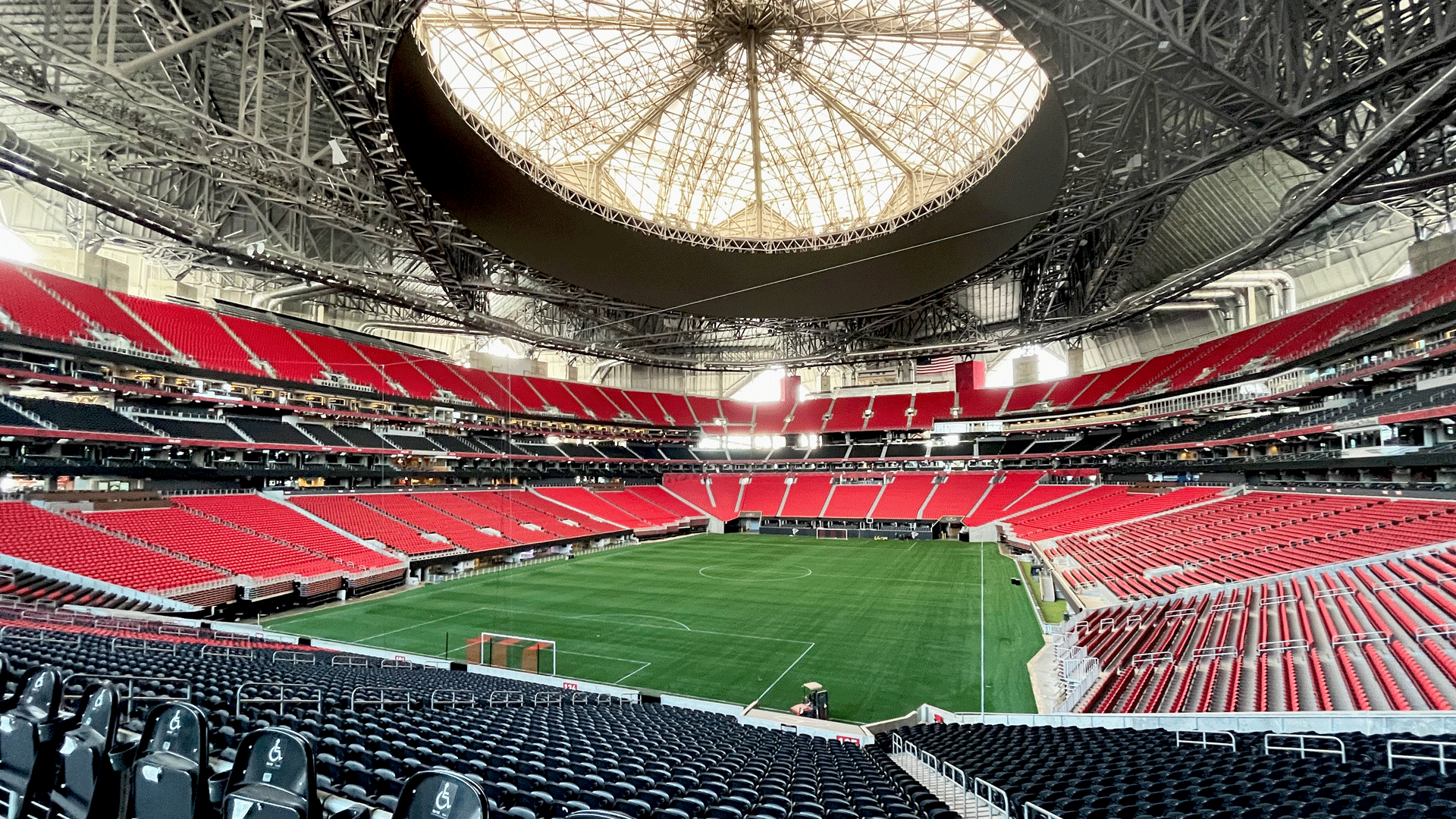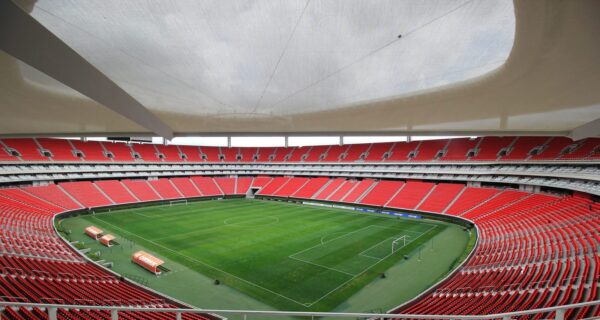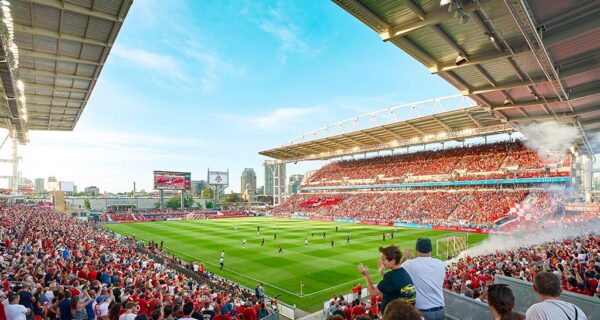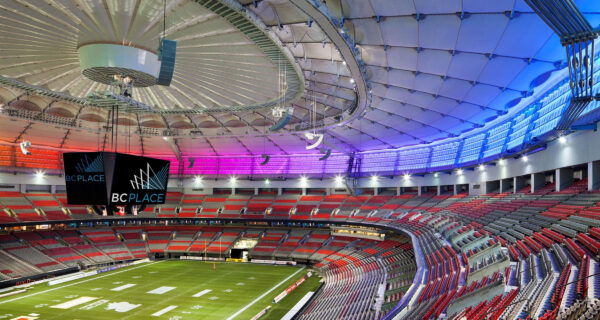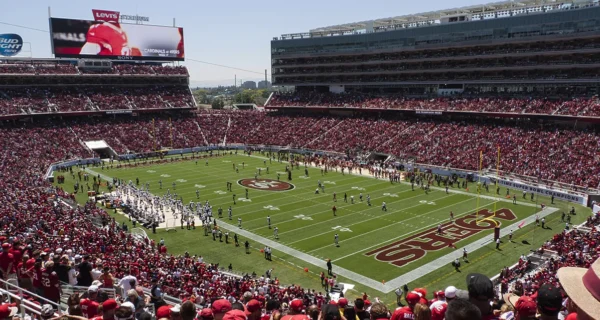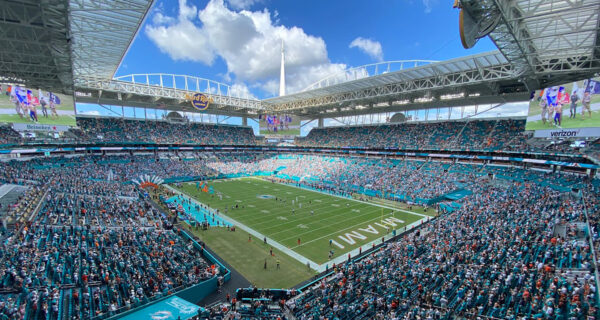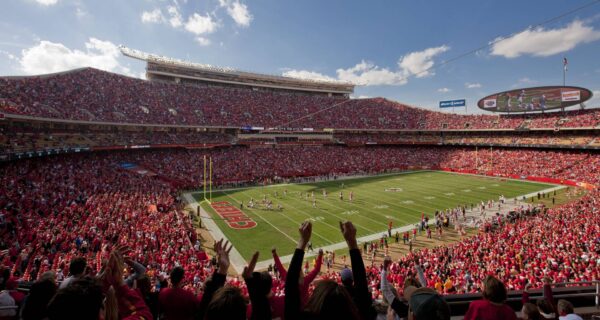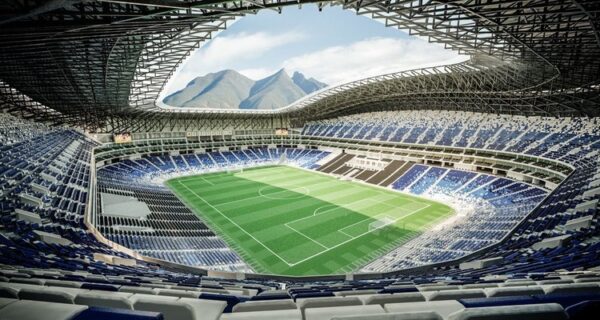Mercedes-Benz Stadium in Atlanta, Georgia will be one of the main venues for the 2026 FIFA World Cup. This amazing stadium offers fans a perfect place to watch the biggest soccer tournament in the world. Located in downtown Atlanta, this state-of-the-art facility is known for its unique design, impressive capacity, and top-notch amenities.
As one of only 11 U.S. venues selected to host matches for the 2026 FIFA World Cup, Mercedes-Benz Stadium is getting ready to welcome soccer fans from around the globe.
Mercedes-Benz Stadium Location and Accessibility
Address and Downtown Setting
Mercedes-Benz Stadium is located at 1 AMB Drive Northwest in Atlanta, Georgia. The stadium sits in the heart of downtown Atlanta, making it easy to reach from many parts of the city.
Built adjacent to where the Georgia Dome once stood, the stadium has become a landmark in Atlanta’s skyline since opening in 2017. Its central location puts it near other popular Atlanta attractions, making it a perfect spot for the World Cup matches.
Transportation Options
Getting to Mercedes-Benz Stadium is simple with several transportation choices available. The MARTA rail system provides two convenient stations near the stadium. The GWCC/CNN Center Station drops you off at the stadium’s front door, making it the preferred station for most visitors. Vine City Station is another good option, just a short walk from the stadium. Both stations help fans avoid traffic and parking hassles.
For those using rideshare services, Mercedes-Benz Stadium has partnered with Lyft to provide dedicated drop-off and pick-up zones. The main Lyft zone is located on Northside Drive, in front of Georgia World Congress Center Building C. Fans exiting from different gates can follow wayfinding signs to reach these designated areas. Other rideshare options, including limousines and buses, can also use these areas.
Parking Facilities
The stadium offers multiple parking options with more than 20,000 parking spots available within a 20-minute walk. In 2025, Mercedes-Benz Stadium announced a new partnership with ParkHub to improve the parking experience. This system allows fans to pre-book official stadium parking or select from third-party locations based on cost and proximity.
Key parking features include:
- EventPass: A reservation platform to pre-book parking.
- SeasonPass: Digital season-long parking passes for regular attendees.
- CompPass: Digital system for distributing parking passes to employees and VIPs.
- 45 nearby parking locations managed by third-party operators.
Pre-booking parking is highly recommended as spaces often sell out before events, especially for major events like World Cup matches.
The Architectural Marvel: Stadium Design
The Iconic Retractable Roof
One of the most impressive features of Mercedes-Benz Stadium is its unique retractable roof. Inspired by the oculus in Rome’s ancient Pantheon, the roof consists of eight triangular panels (often called “petals”) that move in unison along individual tracks. When activated, these petals appear to rotate, opening and closing like a camera aperture. The roof fully opens in just eight minutes and closes in seven minutes.
This engineering marvel weighs approximately 3,500 tons of steel, yet moves with surprising grace. The eight-petal, 3,500-ton system creates either a closed dome or a circular skylight above the center of the field. This innovative design allows events to continue regardless of weather conditions while providing the option of an open-air experience on pleasant days.
Panoramic Views and City Integration
The stadium’s facade follows the roof’s angular form with alternating insulated metal and ETFE panels. The design was inspired by the shape of a falcon’s wing, paying homage to the Atlanta Falcons NFL team. On the stadium’s west side, a 16-story window floods the space with natural daylight and provides stunning panoramic views of Atlanta’s skyline.
This transparent design creates a connection between the events inside the stadium and the surrounding city, making fans feel part of the larger Atlanta experience. The window serves both functional and aesthetic purposes, bringing natural light into the building while showcasing the city.
Construction and Cost
Construction of Mercedes-Benz Stadium began on May 19, 2014, and the facility officially opened on August 26, 2017. The stadium replaced the Georgia Dome, which was demolished shortly after Mercedes-Benz Stadium’s completion. The site of the former Georgia Dome became tailgating space known as the Home Depot Backyard.
The total cost of construction was approximately $1.6 billion (about $2.05 billion in 2024 dollars), making it one of the most expensive stadiums ever built. The project was designed by HOK, tvsdesign, Goode Van Slyke, and Stanley Beaman & Sears, with BuroHappold Engineering/Hoberman serving as the structural engineer.
Capacity and Seating Configuration
Standard Capacity
Mercedes-Benz Stadium offers flexible seating configurations to accommodate different types of events. For American football games, the stadium holds 71,000 fans and can expand to 75,000 for bigger events. For soccer matches, the standard configuration accommodates 42,500 spectators but can expand to 71,000, with standing room allowing for at least 73,019 fans.
This flexibility makes Mercedes-Benz Stadium perfect for hosting events of various sizes, from regular-season games to major international tournaments like the FIFA World Cup.
Record Attendances
The stadium has already set impressive attendance records in its short history. The record for American football stands at 79,330 fans during the 2022 Peach Bowl on December 31, 2022. For soccer, the record is 73,019 spectators during the 2018 MLS Cup on December 8, 2018, when Atlanta United hosted and defeated the Portland Timbers 2-0.
These numbers demonstrate the stadium’s ability to accommodate large crowds while maintaining a quality experience for all attendees.
2026 World Cup Plans
For the 2026 FIFA World Cup, Mercedes-Benz Stadium will undergo significant upgrades to meet FIFA’s detailed requirements. Like other turf venues hosting World Cup matches, the stadium will install new turf to comply with FIFA regulations.
Stadium operators plan to spend approximately $200 million on upgrades over the next few years, with work completed in stages before the summer of 2026. These improvements will ensure the venue meets international standards for such a prestigious tournament.
Premium Amenities and Experiences
Clubs and Suites
Mercedes-Benz Stadium offers a variety of premium seating options for those seeking an elevated experience. The stadium features 190 executive suites and 7,500 club seats, providing 100,000 square feet of luxury space.
Premium options include:
- Maybach and Delta Sky360° On-Field Terraces.
- Loge Boxes with private lounge access.
- AMG Lounge and Truist Club for certain Loge Box holders.
- Dedicated VIP entrances for quick access.
These premium spaces offer not just better views but also enhanced amenities like all-inclusive food and beverages, personal attendants, and comfortable lounge-style seating.
Field-Level Terraces
One of the most unique viewing experiences at Mercedes-Benz Stadium comes from the field-level terraces. These exclusive areas put fans right at field level, allowing them to feel like part of the action.
The terraces feature white-glove service, upscale food options, customizable alcohol selections, personal attendants, and comfortable lounge-style seating directly on Mercedes-Benz Stadium’s field. This premium experience allows fans to watch pre-event and behind-the-scenes activities before heading to their seats for the main event.
Food and Beverage Options
Mercedes-Benz Stadium has revolutionized stadium food with specialty and premium offerings available on all levels. These include custom-developed culinary concepts and unique food and beverage destinations throughout the venue.
The stadium is also known for its 100 Yard Club, a row of concessions stretching the length of the field and bookended by bars. This innovative approach to stadium dining ensures fans have access to quality food and beverages regardless of their seating location.
Technological Features
The Halo Video Board
Perhaps the most impressive technological feature of Mercedes-Benz Stadium is its 360-degree HD “halo” video board built into the roof. This massive display offers clear views from every seat in the house. At the time of its opening, the screen used 37 million LEDs across a total area of 5,793 square meters, making it the largest screen in any sports arena.
The board’s size and geometry were specifically designed to complement the stadium’s roof opening, preserving the beauty of the iconic roof while providing state-of-the-art visual capabilities.
Digital Integration
Mercedes-Benz Stadium features more than 4,000 miles of integrated fiber-optic cable to support the interactive game-day experience. The technology infrastructure includes 2,000 TVs throughout the venue and robust Wi-Fi and cellphone service for all attendees.
These digital amenities ensure fans stay connected and enhance the overall experience, whether they’re checking stats, sharing moments on social media, or keeping up with other games.
Sustainability Initiatives
LEED Platinum Certification
Mercedes-Benz Stadium stands as a leader in environmental responsibility. The venue achieved the highest Leadership in Energy and Environmental Design (LEED) Green Building Rating System certification, setting the bar for environmental responsibility in sports venues around the world.
This commitment to sustainability was part of owner Arthur Blank’s vision from the beginning. When initially told achieving LEED certification at the gold level might not be possible, the team pushed even further and achieved the more prestigious LEED Platinum certification.
Energy and Water Conservation
The stadium incorporates numerous sustainability features:
- 29% savings in energy usage compared to typical stadium designs.
- 4,000 solar panels generating approximately 1.6 million kilowatt hours of renewable energy annually (enough to power 160 Atlanta households).
- Electric car charging stations.
- Onsite edible landscaping.
- 680,000-gallon cistern for water recapture and reuse for land irrigation.
- 1 million gallon cooling tower.
These efforts earned recognition from the White House Office of Science and Technology on the newly formed Green Sports Day in October 2016.
Mercedes-Benz Stadium’s Role in the 2026 FIFA World Cup
Scheduled Matches
Mercedes-Benz Stadium will host eight matches during the 2026 FIFA World Cup:
- Five group stage matches (June 15, 18, 21, 24, and 27)
- One round of 32 match (July 1)
- One round of 16 match (July 7)
- One semi-final match (July 15)
This schedule makes Atlanta’s Mercedes-Benz Stadium one of the key venues for the tournament, hosting matches from the group stage all the way through to the semi-finals.
Expected Game Times
The 2026 World Cup matches at Mercedes-Benz Stadium will likely be played at 12:00, 15:00, 18:00, and 21:00 local time (Eastern Time). This schedule ensures games are accessible to fans across different time zones while providing options for both daytime and evening matches.
FAQs
1. What is the capacity of Mercedes-Benz Stadium for World Cup matches?
For the 2026 FIFA World Cup matches, Mercedes-Benz Stadium will use its soccer configuration, which can accommodate up to 71,000 fans with additional standing room allowing for over 73,000 spectators. This makes it one of the largest venues for the tournament.
2. How can I get to Mercedes-Benz Stadium using public transportation?
The easiest way to reach Mercedes-Benz Stadium via public transportation is using MARTA rail service. The GWCC/CNN Center Station drops you off at the stadium’s front door, while Vine City Station is also nearby. Both stations offer convenient access to the venue without dealing with traffic.
3. Will Mercedes-Benz Stadium’s roof be open or closed during World Cup matches?
This decision will likely be made on a match-by-match basis depending on weather conditions. The retractable roof takes just eight minutes to open and seven minutes to close, giving operators flexibility to adjust as needed for optimal playing conditions.
4. What parking options will be available for World Cup matches?
Multiple parking options will be available, with more than 20,000 spaces within walking distance. Pre-booking through the stadium’s partnership with ParkHub is highly recommended, as parking will likely sell out well in advance for World Cup matches.
5. What food options will be available at Mercedes-Benz Stadium during the World Cup?
Mercedes-Benz Stadium offers a wide variety of food options on all levels, from standard concessions to premium dining experiences. The stadium is known for its fair pricing policy and quality offerings that go beyond typical stadium fare.
6. How many matches will Mercedes-Benz Stadium host during the 2026 World Cup?
Mercedes-Benz Stadium will host eight matches during the 2026 FIFA World Cup, including five group stage matches, one round of 32 match, one round of 16 match, and one semi-final match, making it one of the key venues for the tournament.
7. What changes will be made to Mercedes-Benz Stadium for the World Cup?
The stadium will undergo significant upgrades, including installing new turf to comply with FIFA regulations. Approximately $200 million will be spent on improvements that will be completed in stages before the 2026 World Cup.
8. Is Mercedes-Benz Stadium accessible for people with disabilities?
Yes, the stadium offers comprehensive accessibility features, including accessible parking, accommodative seating, and wheelchair and companion seating on all levels. More detailed information about specific accommodations for the World Cup will be available closer to the event.
9. How early should I arrive for World Cup matches at Mercedes-Benz Stadium?
For World Cup matches, it’s recommended to arrive at least 2-3 hours before kickoff. This allows time for security screening, finding your seat, and experiencing the pre-match atmosphere. Traffic and security will likely be heightened for these international matches.
10. What is unique about Mercedes-Benz Stadium compared to other World Cup venues?
Mercedes-Benz Stadium stands out for its innovative retractable roof that opens like a camera aperture, its 360-degree halo video board, LEED Platinum certification for sustainability, and its integration of technology throughout the venue. These features make it one of the most advanced stadiums hosting the 2026 World Cup.

